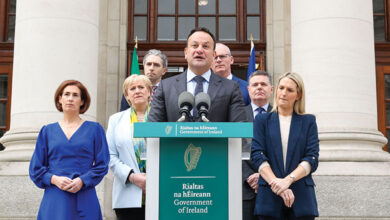Complex planning for border poll must ‘begin immediately’

Only border poll planning can clarify the likely costs and benefits of Irish reunification write Séamus McGuinness, research professor and research area coordinator, and Adele Bergin, Associate Research Professor, with the Economic and Social Research Institute (ESRI).
Subvention describes the gap between government spending allocated to Northern Ireland and the amount raised in taxes paid to the UK Government by its residents and businesses. The issue of subvention is often raised in the context of the Irish unity debate as the cost of administering northern institutions and services that is likely to transfer to the Irish taxpayer in the event of Irish unification.
The most recent estimate of pre-Covid subvention for 2019 was £10.7 billion (FitzGerald and Morgenroth, 2024). Depending on assumptions made around areas – including Northern Ireland’s pension bill, its share of UK debt, public sector pay, and welfare levels – estimated costs that would transfer to the Irish government, following reunification, vary substantially from €2.8 billion to €23.8 billion per annum (Doyle 2021, FitzGerald and Morgenroth 2024).
However, these studies implicitly assume that following a border poll ratifying reunification, reunification effectively takes place instantaneously. They also fail to account for the possibility that reunification could result in changes in the North’s economic performance.
It is not realistic to assume that any Irish Government would allow for a border poll to occur without appropriate prior planning that would include a transition period during which both operational and fiscal responsibilities would be transferred from the UK to the Republic. The objectives of border poll planning should be to maximise the benefits and minimise the costs of reunification and ensure a smooth transition to constitutional change.
Planning for a border poll should focus on how to address the cause of Northern Ireland’s subvention requirement – low productivity – in the period including and beyond any transition, which, if successful, would effectively reduce subvention requirements.
Productivity levels in Northern Ireland were broadly similar to those of the Republic in 2000; however, a 40 per cent gap had emerged by 2022 as a consequence of a slight upward productivity trend in the North and declining productivity in the Republic.
Bergin and McGuinness (2022) highlighted the causes of Northern Ireland’s productivity problem as a combination of relatively poor educational attainment, low levels of investment, and a lack of export intensive firms. The factors driving this low productivity can potentially be influenced by changes in policy. As a result, key objectives of border poll planning should seek to identify the optimum changes in educational, industrial, and infrastructural policy that will generate the most effective improvements in productivity. Improvements in productivity will have the impact of lowering subvention requirements.
Of course, effecting change in educational provision, improving investment levels, and reforming industrial policy in Northern Ireland will be extremely costly. It is reasonable to expect that external actors, such as the EU, the USA, and potentially the departing UK administration, will play some role in financing structural reforms. However, it is likely that such commitments will only transpire post-referendum and will be difficult to quantify in advance.
Detailed planning is an essential component to ensuring that voters are reliably informed of the potential costs and benefits of Irish reunification in advance of any border poll. The generation of partial or static estimates serve limited purpose as they do not reflect the dynamic nature of any future reunification process.
Necessary planning and preparation goes well beyond the use of such frameworks; it requires the use of macroeconomic and microsimulation tools to model the impacts of various productivity enhancing policy changes over a number of time horizons, incorporating various tax and welfare scenarios adjusted for expected demographics and including sensitivity estimates that account for potential unknown factors. Such a complex planning process can only be effectively commissioned and managed by the Irish Government and given the levels of uncertainty around the timing of a future border boll, it is prudent for the process to begin immediately.





